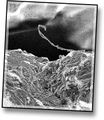File:Implant Biocompatibility-1.jpg and Iodine: Difference between pages
(== Summary == import files from local) Tag: Server-side upload |
(Page conversion via llm-mediawiki-rev -jwm) |
||
| Line 1: | Line 1: | ||
== | '''Iodine''' (from the Greek ''Iodes'', meaning violet; chemical symbol '''I''') is an element first discovered, accidentally, by Barnard Courtois in 1811. It is a dark purple-black solid that sublimates at standard temperature and pressure into a purplish gas with an irritating odor. Iodine has atomic number 53, and is a halogen (Gr. ''hals'', salt, ''genes'', forming): Group VII in the periodic table of the elements. It is the least active element of this group, and is only slightly soluble in water, where it gives a yellow-brown solution. | ||
Iodine is required in trace amounts for most living organisms. In adults deficiency leads to goitre (hyperthyroidism - inflammation of the thyroid) whilst children born to iodine-deficient mothers suffer mental retardation and other congenital brain abnormalities. To prevent against iodine deficiency, table salt is generally sold with iodine added to it. | |||
Iodine solutions are excellent disinfectants, and is often used to [[Disinfect|disinfect]] the skin before surgery, giving blood, and sometimes before piercing. | |||
== Risks == | |||
Iodine should be handled with care, as direct contact will cause lesions on the skin. Iodine vapor is extremely irritating to the mucus membranes and the eye. | |||
Latest revision as of 06:03, 17 September 2023
Iodine (from the Greek Iodes, meaning violet; chemical symbol I) is an element first discovered, accidentally, by Barnard Courtois in 1811. It is a dark purple-black solid that sublimates at standard temperature and pressure into a purplish gas with an irritating odor. Iodine has atomic number 53, and is a halogen (Gr. hals, salt, genes, forming): Group VII in the periodic table of the elements. It is the least active element of this group, and is only slightly soluble in water, where it gives a yellow-brown solution.
Iodine is required in trace amounts for most living organisms. In adults deficiency leads to goitre (hyperthyroidism - inflammation of the thyroid) whilst children born to iodine-deficient mothers suffer mental retardation and other congenital brain abnormalities. To prevent against iodine deficiency, table salt is generally sold with iodine added to it.
Iodine solutions are excellent disinfectants, and is often used to disinfect the skin before surgery, giving blood, and sometimes before piercing.
Risks
Iodine should be handled with care, as direct contact will cause lesions on the skin. Iodine vapor is extremely irritating to the mucus membranes and the eye.
File history
Click on a date/time to view the file as it appeared at that time.
| Date/Time | Thumbnail | Dimensions | User | Comment | |
|---|---|---|---|---|---|
| current | 01:42, 4 June 2023 |  | 228 × 262 (14 KB) | Bmezine (talk | contribs) | == Summary == import files from local |
You cannot overwrite this file.
File usage
The following page uses this file: